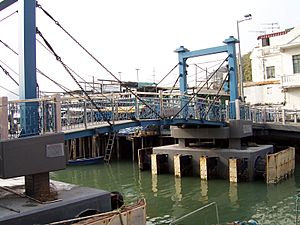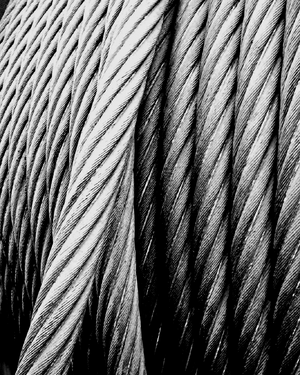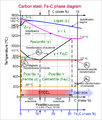Steel facts for kids
Steel is a super strong metal! It's mostly iron mixed with a little bit of carbon, and sometimes other metals too. This mix makes steel much harder and stronger than pure iron. If iron has more than 1.7% carbon, it's called cast iron. Steel is also different from wrought iron, which has almost no carbon.
Contents
How We Make Steel
People have been making steel for a very long time! In places like India and Sri Lanka, small amounts of steel were made over 2,500 years ago. Back then, it was super expensive and often used for making swords and knives. In the Middle Ages, making steel was a slow process, so only small amounts could be made.
Over time, how we make steel has changed a lot. Around 1610, people in England started making steel, and the methods got better and cheaper over the next 100 years. This cheaper steel helped kick off the Industrial Revolution in England and Europe. One of the first big machines for making cheap steel was the Bessemer converter.
Today, the most common way to make steel is called the basic-oxygen process. Imagine a giant, turnip-shaped container! Inside, liquid raw iron (called "pig iron") is poured in. Some scrap metal is added to help control the heat. Then, oxygen is blown into the iron. This oxygen burns away extra carbon and other unwanted bits. After that, just enough carbon is added back to get the right mix. The liquid steel is then poured out. It can be shaped into molds or rolled into long sheets, beams, and even railway tracks! Some special steels are made in huge electric arc furnaces.
Most steel is made by machines in giant buildings called steel mills. Steel is a very affordable metal, which is why it's used to make so many things. It's used in buildings, bridges, and all kinds of machines. Almost all ships and cars today are made from steel. When a steel object gets old or breaks, it's called scrap. The cool thing is, this scrap can be melted down and reshaped into something new! Steel is a recyclable material, meaning it can be used again and again.
What Steel is Made Of
Steel is a metal alloy, which means it's a mix of metals. Its main ingredients are iron and usually some carbon.
Everything around us is made of tiny parts called atoms. In pure iron, these atoms can slide past each other easily, making it soft. But when other atoms, like carbon, are added, they get in the way. This stops the iron atoms from sliding apart so easily, making the metal much stronger and harder!
Changing how much carbon (or other atoms) is added to steel changes its useful qualities. These qualities are called the properties of the steel. Some important properties are:
- Hardness: How tough it is.
- How easily it bends: Is it stiff or flexible?
- Ductility: Can it be stretched into thin wires?
- Strength: How much force it can handle before breaking.
- Is it magnetic?: Can a magnet pick it up?
- Will it rust?: Does it get damaged by air and water?
The main chemical parts of steel are iron, carbon, manganese, silicon, phosphorus, and sulfur. Sometimes, other special metals are added too. Steel is quite heavy, with a density of 7,850 kg/m3, and it melts at a very hot temperature of 1,510 °C.
Carbon is the most important element for making steel hard. Steel with more carbon is harder and stronger than pure iron. However, it can also become more easily broken, which is called being brittle.
Different Kinds of Steel
There are thousands of different types of steel! Each type is made with a unique mix of chemical elements.
All steels have some elements that aren't so good, like phosphorus (P) and sulfur (S). Steel makers try to remove as much of these as possible.
Plain carbon steels are made only of iron, carbon, and those unwanted elements. There are three main groups:
- Steel with a small amount of carbon (0.05% to 0.2%) doesn't get harder when cooled quickly. It's easy to weld, so it's used for things like shipbuilding, pipes, and fence wire where low cost is important.
- Other plain steels are used for springs, gears, and engine parts.
- Plain carbon steel with more carbon (0.45% to 0.8%) is used for very hard items like shears and machine tools.
Alloy steels are plain carbon steels that have other metals added to them. These can include Boron (B), manganese (Mn), chromium (Cr), nickel (Ni), molybdenum (Mo), tungsten (W), and cobalt (Co). These added metals give the steel special properties that plain carbon steel doesn't have. Alloy steels are made for specific jobs. For example, adding chromium makes stainless steel, which doesn't rust easily. Adding boron can make steel very hard without making it too brittle.
What We Use Steel For
People make a huge number of things from steel. It's one of the most common and useful metals in the world! Many items that used to be made from iron are now made of steel. Some of these include:
- Tools for building and fixing things.
- All kinds of machines.
- Motors and engines for vehicles.
- Wires for electricity and other uses.
- Rails for trains to run on.
- Big buildings and tall skyscrapers.
- Strong Bridges.
- Bars used to make reinforced concrete stronger.
- The hulls (bodies) of ships and large boats.
- Bodies of Cars and trains.
- Major home appliances like refrigerators and washing machines.
- Cutlery and knives for eating and cooking.
Recycling Steel
Steel is one of the most-recycled materials on Earth! More than 60% of all steel is recycled globally. In the United States alone, over 82 million metric tons were recycled in 2008. This means about 83% of all steel was recycled that year!
Even though a lot of steel is recycled, we still make more new steel than we scrap. In 2016, about 1.6 billion tons of new steel were made worldwide, and about 630 million tons were recycled. This shows how much we use steel every day!
Images for kids
-
The steel cable of a colliery winding tower
-
Incandescent steel workpiece in this depiction of the blacksmith's art
-
Iron ore pellets for the production of steel
-
Bloomery smelting during the Middle Ages
-
A Bessemer converter in Sheffield, England
-
A Siemens-Martin open hearth furnace in the Brandenburg Museum of Industry
-
Bethlehem Steel in Bethlehem, Pennsylvania (picture) was one of the world's largest manufacturers of steel before its closure in 2003.
-
A stainless steel gravy boat
See also
 In Spanish: Acero para niños
In Spanish: Acero para niños



















